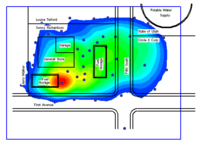GMS:Converting 2D Scatter Points to Other Types of Data: Difference between revisions
From XMS Wiki
Jump to navigationJump to search
No edit summary |
No edit summary |
||
| Line 2: | Line 2: | ||
2D Scatter Points may be converted to other types of data used in GMS, such as a [[GMS:TIN Module|TIN]], [[GMS:2D Mesh Module|2D Mesh Nodes]], or [[GMS:Observations|Observation Points]]. 2D Scatter Points are converted by using the following commands in the Scatter Points menu: | 2D Scatter Points may be converted to other types of data used in GMS, such as a [[GMS:TIN Module|TIN]], [[GMS:2D Mesh Module|2D Mesh Nodes]], or [[GMS:Observations|Observation Points]]. 2D Scatter Points are converted by using the following commands in the Scatter Points menu: | ||
*''Scatter Points | *''Scatter Points → TIN'' | ||
*:The Scatter Points | *:The Scatter Points → TIN command creates a set of TIN vertices. These vertices are automatically triangulated to form a TIN. | ||
*''Scatter Points | *''Scatter Points → Mesh Nodes'' | ||
*:The Scatter Points | *:The Scatter Points → Mesh Nodes command creates a set of 2D finite element nodes from the points in the active scatter point set. | ||
*''Scatter Points | *''Scatter Points → Obs. Pts.'' | ||
*:The Scatter Points | *:The Scatter Points → Obs. Pts command creates one observation point for each of the scatter points in the active scatter point set. The active dataset values become the measured values for the observation points. You must create a coverage with a measurement before executing this command. | ||
{{Version GMS 8.3}} | {{Version GMS 8.3}} | ||
*''Scatter Points | *''Scatter Points → 3D Scatter Points'' | ||
*:The Scatter Points | *:The Scatter Points → 3D Scatter Points command creates a 3D scatter point set from the 2D scatter points. All of the datasets are copied to the 3D scatter points. The Z (elevation) of the 3D scatter points is set to the Z of the 2D scatter points at the time of conversion. | ||
{{Navbox GMS}} | {{Navbox GMS}} | ||
[[Category:2D Scatter Point]] | [[Category:2D Scatter Point]] | ||
